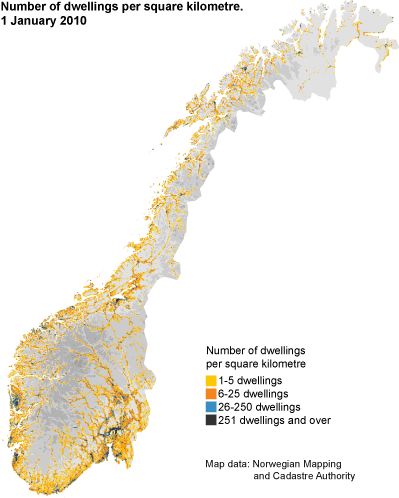Content
Published:
This is an archived release.
Dwelling stock on the map
The number of dwellings has passed 2.3 million. Dwelling stock is now also published on maps that display density and spatial distribution of dwellings. Ninety-nine per cent of the dwelling stock is placed on the map.
There were a total of 2 323 925 dwellings in Norway as at 1 January 2010, with more than half (1 219 903) being in detached houses. Flats in multi-dwelling buildings followed with 522 992, while there where 267 821 dwellings in row houses, linked houses and houses with three or four dwellings. There were 211 596 dwellings in houses with two dwellings and 41 195 dwellings in residences for communities. The remaining 60 418 dwellings are registered in buildings where the main part of the floor space is used for purposes other than dwellings, mainly industrial buildings.
Unequal standard of dwellings
Dwelling stock statistics also show different indicators for quality of dwellings, in terms of number of rooms, baths, toilets, access to kitchen facilities, position of dwelling in building, and utility floor space of dwellings.
Figures show that about half of the dwellings only have one toilet. While nine out of ten dwellings in multi-dwelling buildings only have one toilet and one bath, dwellings in detached houses have a much higher frequency of more than one toilet and bathroom. About half of all dwellings in detached houses have more than one toilet, and one third have more than one bathroom.
Figures also show differences in dwellings with respect to utility floor space and number of rooms. While half of the dwellings in detached houses have 4 rooms or more, only every fifth flat in multi-dwelling buildings has more than 4 rooms. Two thirds of flats in multi-dwelling buildings have less than 80 square metres of utility floor space, whilst only one in ten dwellings in detached houses are smaller than 80 square metres.
About 1 in 20 dwellings have their entrance in the basement, whilst entrances to more than seven out of ten dwellings are on the ground floor. A total of 99.6 per cent of the dwellings, for which information exists, have access to kitchen facilities. Almost half of the dwellings are in buildings on three or more floors.
More figures are available at StatBank .
Comparability with the Housing Census in 2001The register-based dwelling statistics cannot be compared directly with the Housing Census in 2001 . The Housing Census covered 1.96 million occupied dwellings, while the statistics on the dwelling stock include all dwellings, both occupied and vacant. Improvement of the GAB register/MatrikkelenThe municipalities are cleaning up their registers to improve the quality. This is being done on an ongoing basis and also especially in connection with the transition to the new official building register, “Matrikkelen”. Dwellings that were incorrectly classified the previous year may have been assigned the correct information the following year. The number of registered dwellings in the municipalities may also change from year to year because of the clean up. As a result, the number of dwellings in some of the municipalities may not be directly comparable with the previous year. Extension of the statisticsThe plan is then to extend the statistics with more information about the dwellings. In the future it is also the plan to distinguish between occupied and vacant dwellings. More about comparability, quality and other information can be found in “About the statistics” . |
Contact
-
Jens Mathiesen
E-mail: jens.mathiesen@ssb.no
tel.: (+47) 40 81 13 98
-
Mona Takle
E-mail: mona.takle@ssb.no
tel.: (+47) 40 81 14 12

